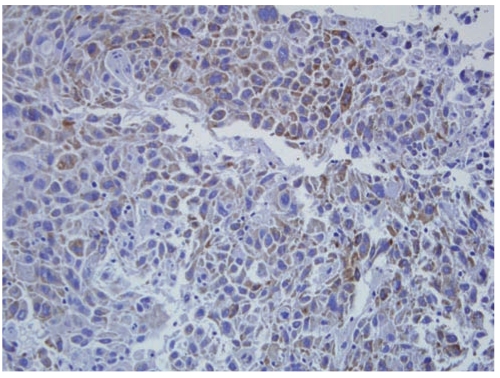Cancer Res Treat.
2012 Mar;44(1):57-62.
Immunohistochemical Expression of DCUN1D1 in Non-small Cell Lung Carcinoma: Its Relation to Brain Metastasis
- Affiliations
-
- 1Department of Pathology, St. Vincent's Hospital, The Catholic University of Korea School of Medicine, Seoul, Korea. sjkang@catholic.ac.kr
- 2Department of Pathology, Seoul St. Mary's Hospital, The Catholic University of Korea School of Medicine, Seoul, Korea.
- 3Department of Nuclear Medicine, Seoul St. Mary's Hospital, The Catholic University of Korea School of Medicine, Seoul, Korea.
- 4Department of Neurosurgery, St. Vincent's Hospital, The Catholic University of Korea School of Medicine, Seoul, Korea.
- 5Department of Pathology, Yeouido St. Mary's Hospital, The Catholic University of Korea School of Medicine, Seoul, Korea.
Abstract
- PURPOSE
Non-small cell lung carcinoma (NSCLC) comprises 75-85% of all lung cancers, and approximately 25% of all NSCLC patients develop brain metastasis. There are no reliable markers for predicting in which patients this metastasis will occur. DCUN1D1, also known as squamous cell carcinoma-related oncogene, is associated with tumor progression and poor outcomes in NSCLC. The objective of this study was to investigate the role of DCUN1D1 expression in cases of brain metastasis due to NSCLC.
MATERIALS AND METHODS
Primary tumor samples from a total of 71 cases of NSCLC, either with (n=40) or without (n=31) brain metastasis, were evaluated for DCUN1D1 expression by immunohistochemistry analysis.
RESULTS
DCUN1D1 expression was detected in 16 patients (23%) and tended to correlate with T classification (15% of T1-2 tumors vs. 30% of T3-4 tumors, p=0.083). DCUN1D1 expression was significantly associated with tumor stage. It was observed in none of the patients with stage I disease, 10% of those with stage II disease, and 29% with stage III disease (p=0.009). In addition, 14 of 16 DCUN1D1-positive patients resulted in brain metastasis (p=0.01). The odds ratio of brain metastasis for patients with DCUN1D1 expression was 3.112 (p=0.009).
CONCLUSION
DCUN1D1 expression may play a role in tumor progression and development of brain metastasis in patients with NSCLC. Evaluation of DCUN1D1 expression may provide assistance in identifying those patients who are at higher risk for brain metastasis.
Figure
Reference
-
1. Schuette W. Treatment of brain metastases from lung cancer: chemotherapy. Lung Cancer. 2004; 45(Suppl 2):S253–S257. PMID: 15552807.
Article2. Palmieri D, Chambers AF, Felding-Habermann B, Huang S, Steeg PS. The biology of metastasis to a sanctuary site. Clin Cancer Res. 2007; 13:1656–1662. PMID: 17363518.
Article3. Saad AG, Yeap BY, Thunnissen FB, Pinkus GS, Pinkus JL, Loda M, et al. Immunohistochemical markers associated with brain metastases in patients with nonsmall cell lung carcinoma. Cancer. 2008; 113:2129–2138. PMID: 18720359.
Article4. Arnold SM, Young AB, Munn RK, Patchell RA, Nanayakkara N, Markesbery WR. Expression of p53, bcl-2, E-cadherin, matrix metalloproteinase-9, and tissue inhibitor of metalloproteinases-1 in paired primary tumors and brain metastasis. Clin Cancer Res. 1999; 5:4028–4033. PMID: 10632335.5. Shabani HK, Kitange G, Tsunoda K, Anda T, Tokunaga Y, Shibata S, et al. Immunohistochemical expression of E-cadherin in metastatic brain tumors. Brain Tumor Pathol. 2003; 20:7–12. PMID: 14604226.
Article6. Grinberg-Rashi H, Ofek E, Perelman M, Skarda J, Yaron P, Hajdúch M, et al. The expression of three genes in primary non-small cell lung cancer is associated with metastatic spread to the brain. Clin Cancer Res. 2009; 15:1755–1761. PMID: 19190132.
Article7. Singh B, Gogineni SK, Sacks PG, Shaha AR, Shah JP, Stoffel A, et al. Molecular cytogenetic characterization of head and neck squamous cell carcinoma and refinement of 3q amplification. Cancer Res. 2001; 61:4506–4513. PMID: 11389082.8. Sarkaria I, O-charoenrat P, Talbot SG, Reddy PG, Ngai I, Maghami E, et al. Squamous cell carcinoma related oncogene/DCUN1D1 is highly conserved and activated by amplification in squamous cell carcinomas. Cancer Res. 2006; 66:9437–9444. PMID: 17018598.
Article9. Broderick SR, Golas BJ, Pham D, Towe CW, Talbot SG, Kaufman A, et al. SCCRO promotes glioma formation and malignant progression in mice. Neoplasia. 2010; 12:476–484. PMID: 20563250.
Article10. Sarkaria IS, Pham D, Ghossein RA, Talbot SG, Hezel M, Dudas ME, et al. SCCRO expression correlates with invasive progression in bronchioloalveolar carcinoma. Ann Thorac Surg. 2004; 78:1734–1741. PMID: 15511464.
Article11. O-charoenrat P, Sarkaria I, Talbot SG, Reddy P, Dao S, Ngai I, et al. SCCRO (DCUN1D1) induces extracellular matrix invasion by activating matrix metalloproteinase 2. Clin Cancer Res. 2008; 14:6780–6789. PMID: 18980971.12. Kim AY, Bommeljé CC, Lee BE, Yonekawa Y, Choi L, Morris LG, et al. SCCRO (DCUN1D1) is an essential component of the E3 complex for neddylation. J Biol Chem. 2008; 283:33211–33220. PMID: 18826954.
Article13. Talbot SG, O-charoenrat P, Sarkaria IS, Ghossein R, Reddy P, Ngai I, et al. Squamous cell carcinoma related oncogene regulates angiogenesis through vascular endothelial growth factor-A. Ann Surg Oncol. 2004; 11:530–534. PMID: 15123463.
Article
- Full Text Links
- Actions
-
Cited
- CITED
-
- Close
- Share
- Similar articles
-
- Expression of p53 and nm23 Proteins in Non-Small Cell Lung Cancer
- Two Cases of Cutaneous Metastasis from Small Cell Lung Cancer
- A Case of Iris Metastasis from Non-small Cell Lung Cancer
- Immunohistochemical Staining of Insulin-like Growth Factor-1 in Human Lung Cancer cells of NSCLC and SCLC
- CT findings of mediastinal lymph node metastasis in bronchogenic carcinoma of the lung: A comparative study of small cell carcinoma vs non-small cell carcinoma


